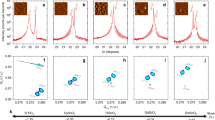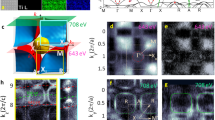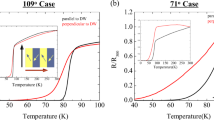Abstract
Multiferroic materials possess two or more ferroic orders but have not been exploited in devices owing to the scarcity of room-temperature examples. Those that are ferromagnetic and ferroelectric have potential applications in multi-state data storage if the ferroic orders switch independently, or in electric-field controlled spintronics if the magnetoelectric coupling is strong. Future applications could also exploit toroidal moments and optical effects that arise from the simultaneous breaking of time-reversal and space-inversion symmetries. Here, we use soft X-ray resonant magnetic scattering and piezoresponse force microscopy to reveal that, at the interface with Fe or Co, ultrathin films of the archetypal ferroelectric BaTiO3 simultaneously possess a magnetization and a polarization that are both spontaneous and hysteretic at room temperature. Ab initio calculations of realistic interface structures provide insight into the origin of the induced moments and bring support to this new approach for creating room-temperature multiferroics.
This is a preview of subscription content, access via your institution
Access options
Subscribe to this journal
Receive 12 print issues and online access
$259.00 per year
only $21.58 per issue
Buy this article
- Purchase on Springer Link
- Instant access to full article PDF
Prices may be subject to local taxes which are calculated during checkout




Similar content being viewed by others
References
Hill, N. A. Why are there so few magnetic ferroelectrics? J. Phys. Chem. B. 104, 6694–6709 (2000).
Cheong, S-W. & Mostovoy, M. Multiferroics: A magnetic twist for ferroelectricity. Nature Mater. 6, 13–20 (2007).
Eerenstein, W., Mathur, N. D. & Scott, J. F. Multiferroic and magnetoelectric materials. Nature 442, 759–765 (2006).
Béa, H., Gajek, M., Bibes, M. & Barthélémy, A. Spintronics with multiferroics. J. Phys.: Condens. Matter 20, 434221 (2008).
Bibes, M., Villlegas, J. E. & Barthélémy, A. Ultrathin oxide films and interfaces for electronics and spintronics. Adv. Phys. 60, 5–84 (2011).
Binek, C. & Doudin, B. Magnetoelectronics with magnetoelectrics. J. Phys.: Condens. Matter. 17, L39–L44 (2005).
Chu, Y-H. et al. Electric-field control of local ferromagnetism using a magnetoelectric multiferroic. Nature Mater. 7, 478–482 (2008).
Bibes, M. & Barthélémy, A. Towards a magnetoelectric memory. Nature Mater. 7, 425–426 (2008).
Wood, V. E & Austin, A. E. in Magnetoelectric Interaction Phenomena in Crystals (eds Freeman, A. J. & Schmid, H.) (Gordon and. Breach, 1975).
Gajek, M. et al. Tunnel junctions with multiferroic barriers. Nature Mater. 6, 296–302 (2007).
Rikken, G. L. J. A. & Raupach, E. Observation of magneto-chiral dichroism. Nature 390, 493–494 (1997).
Sawada, K. & Nagaosa, N. Optical magnetoelectric effect in multiferroic materials: Evidence for a Lorentz force acting on a ray of light. Phys. Rev. Lett. 95, 237402 (2005).
Catalan, G. & Scott, J. F. Physics and applications of bismuth ferrite. Adv. Mater. 21, 2463–2485 (2009).
Lee, J. H. et al. A strong ferroelectric ferromagnet created by means of spin-lattice coupling. Nature 466, 954–958 (2010).
Hu, J., Li, J. & Nan, C-W. Recent progress in multiferroic magnetoelectric composites: From bulk to thin films. Adv. Mater. 23, 1062–1087 (2011).
Duan, C-G., Jaswal, S. S. & Tsymbal, E. Y. Predicted magnetoelectric effect in Fe/BaTiO3 multilayers: Ferroelectric control of magnetism. Phys. Rev. Lett. 97, 047201 (2006).
Fechner, M. et al. Magnetic phase transition in two-phase multiferroics predicted from first principles. Phys. Rev. B 78, 212406 (2008).
Lee, J., Sai, N., Cai, T., Niu, Q. & Demkov, A. A. Interfacial magnetoelectric coupling in tricomponent superlattices. Phys. Rev. B 81, 144425 (2010).
Kitagawa, Y. et al. Low-field magnetoelectric effect at room temperature. Nature Mater. 9, 797–802 (2010).
Garcia, V. et al. Giant tunnel electroresistance for non-destructive readout of ferroelectric states. Nature 460, 81–84 (2009).
Garcia, V. et al. Ferroelectric control of spin-polarization. Science 327, 1106–1110 (2010).
Chen, C. T. et al. Experimental confirmation of the X-ray magnetic circular dichroism sum rules for iron and cobalt. Phys. Rev. Lett. 75, 152–155 (1995).
Abrudan, R. et al. Structural and magnetic properties of epitaxial Fe/CoO bilayers on Ag(001). Phys. Rev. B 77, 014411 (2008).
Noguès, J. et al. Exchange bias in nanostructures. Phys. Rep. 422, 65–117 (2005).
Jullière, M. Tunneling between ferromagnetic films. Phys. Lett. A 54, 225–226 (1975).
Bowen, M. et al. Nearly total spin-polarization in La2/3Sr1/3MnO3 from tunneling experiments. Appl. Phys. Lett. 82, 233–235 (2003).
Zhuravlev, M. Y., Sabirianov, R. F., Jaswal, S. S. & Tsymbal, E. Y. Giant electroresistance in ferroelectric tunnel junctions. Phys. Rev. Lett. 94, 246802 (2005).
Kohlstedt, H., Pertsev, N. A., Rodriguez Contreras, J. & Waser, R. Theoretical current–voltage characteristics of ferroelectric tunnel junctions. Phys. Rev. B 72, 125341 (2005).
Cao, D., Cai, M-Q., Hu, W. Y. & Xu, C-M. Magnetoelectric effect and critical thickness for ferroelectricity in Co/BaTiO3/Co multiferroic tunnel junctions. J. Appl. Phys. 109, 114107 (2011).
de Teresa, J. M. et al. Role of metal-oxide interface in determining the spin polarization of magnetic tunnel junctions. Science 286, 507–509 (1999).
Valencia, S. et al. B. X-ray magnetic circular dichroism in reflection geometry: A tool for investigating surface magnetism in thin films. J. Appl. Phys. 104, 023903 (2008).
Zhuravlev, M. Y., Vedyayev, A. V. & Tsymbal, E. Y. Interlayer exchange coupling across a ferroelectric barrier. J. Phys.: Condens. Matter. 22, 352203 (2010).
Gonze, X. et al. A brief introduction to the ABINIT software package. Z. Kristallogr. 220, 558–562 (2005).
Gonze, X. et al. ABINIT: First-principles approach of materials and nanosystem properties. Comput. Phys. Commun. 180, 2582–2615 (2009).
Shao, Y. et al. Quantification of the Ti oxidation state in BaTi1−xNbxO3 compounds. Ultramicroscopy 110, 1014–1019 (2010).
Garcia-Barriocanal, J. et al. Spin and orbital Ti magnetism at LaMnO3/SrTiO3 interfaces. Nature Commun. 1, 82 (2010).
Fujii, T. et al. Large magnetic polarization of Ti4+ ions in FeTiO3 . J. Magn. Magn. Mater. 310, e555–e557 (2006).
Brice-Profeta, S. Etude de l’Ordre Chimique et Magnétique d’Oxydes Spinelles de Taille Nanométrique par Dichroïsme Magnétique Circulaire des Rayons X. PhD thesis, Univ. Pierre et Marie Curie (2004).
Yu, P. et al. Interface ferromagnetism and orbital reconstruction in BiFeO3–La0.7Sr0.3MnO3 heterostructures. Phys. Rev. Lett. 105, 027201 (2010).
Sefrioui, Z. et al. All-manganite tunnel junctions with interface-induced barrier magnetism. Adv. Mater. 22, 5029–5034 (2010).
Jang, F. et al. Eight logic states of tunneling magnetoelectroresistance in multiferroic tunnel junctions. J. Appl. Phys. 102, 044504 (2007).
Wang, J. & Li, Z. Y. Multiple switching of spin polarization injected into a semiconductor by a multiferroic tunneling junction. J. Appl. Phys. 104, 033908 (2008).
Spaldin, N. A., Fiebig, M. & Mostovoy, M. The toroidal moment in condensed-matter physics and its relation to the magnetoelectric effect. J. Phys.: Condens. Matter 20, 434203 (2008).
Oleinik, I. I., Tsymbal, E. Y. & Pettifor, D. G. Atomic and electronic structure of Co/SrTiO3/Co magnetic tunnel junctions. Phys. Rev. B. 65, 020401(R) (2001).
Bowen, M. et al. Absence of induced moment in magnetic tunnel junction barriers. Phys. Rev. B 73, 012405 (2006).
Bouzehouane, K. et al. Nanolithography based on real-time electrically controlled indentation with an atomic force microscope for nanocontact elaboration. Nano Lett. 3, 1599–1602 (2003).
Houzé, F., Meyer, R., Schneegans, O. & Boyer, L. Imaging the local electrical properties of metal surfaces by atomic force microscopy with conducting probes. Appl. Phys. Lett. 69, 1975–1977 (1996).
Rodriguez, B. J., Callahan, C., Kalinin, S. V. & Proksch, R. Dual-frequency resonance-tracking atomic force microscopy. Nanotechnology 18, 475504 (2007).
Grabis, J., Nefedov, A. & Zabel, H. Diffractometer for soft x-ray resonant magnetic scattering. Rev. Sci. Instrum. 74, 4048–4051 (2003).
Acknowledgements
This study was partially supported by France-UK PHC Alliance program, the Triangle de la Physique contract ‘OXISPINTRONICS’, UK EPSRC EP/E026206/I, Region Île-de-France in the framework of C’Nano IdF, the European ESTEEM and the METSA networks and the European Research Council Advanced grant project ‘FEMMES’ (no. 267579). The ALICE diffractometer is funded through the BMBF Contract No. 05K10PC2. The research leading to these results has received funding from the European Community’s Seventh Framework Programme (FP7/2007-2013) under grant agreement no. 226716. X.M. acknowledges support from a Herschel–Smith fellowship. We also thank N. Reyren, V. Cros and F. Petroff for discussions.
Author information
Authors and Affiliations
Contributions
S.V., V.G., A.B. and M.B. designed the experiments. X.M., N.D.M., R.O.C., C.D., K.B. and S.F. were responsible for the preparation and characterization of the samples. A.C., V.G., K.B., A.B. and M.B. performed the magnetotransport measurements and data analysis. S.V., A.C., V.G., A.Gaupp, L.B., R.A. and F.R. performed the XRMS, XAS and XMCD measurements and treated and interpreted the data. A.C., V.G., K.B. and S.F. carried out the PFM characterization. L.B. and A.Gloter performed the STEM-HAADF studies, the EELS measurements and interpreted the data. L.B., A.Gloter and A.Z. carried out the first-principles calculations and interpreted the results. S.V. and M.B. wrote the manuscript. All authors contributed to the manuscript and the interpretation of the data.
Corresponding author
Ethics declarations
Competing interests
The authors declare no competing financial interests.
Supplementary information
Supplementary Information
Supplementary Information (PDF 1313 kb)
Rights and permissions
About this article
Cite this article
Valencia, S., Crassous, A., Bocher, L. et al. Interface-induced room-temperature multiferroicity in BaTiO3. Nature Mater 10, 753–758 (2011). https://doi.org/10.1038/nmat3098
Received:
Accepted:
Published:
Issue Date:
DOI: https://doi.org/10.1038/nmat3098
This article is cited by
-
Effect of Cobalt Doping on the Structural, Linear, and Nonlinear Optical Properties in Ba1−xCoxTiO3 Perovskites
Journal of Electronic Materials (2023)
-
Electrical switching of spin-polarized current in multiferroic tunneling junctions
npj Computational Materials (2022)
-
Voltage control of ferrimagnetic order and voltage-assisted writing of ferrimagnetic spin textures
Nature Nanotechnology (2021)
-
In situ X-ray measurements over large Q-space to study the evolution of oxide thin films prepared by RF sputter deposition
Journal of Materials Science (2021)
-
Tuning the interfacial spin-orbit coupling with ferroelectricity
Nature Communications (2020)



